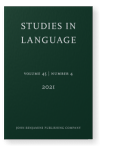Vol. 45:4 (2021) ► pp.753–790
Prolegomena to a theory of chorophorics
The goal of this paper is to offer a theoretical analysis of chorophorics, a recently proposed pro-formal category that can refer either to “places”, or to locations as arguments of spatial relations. It is suggested that chorophorics are a common category that displays heterogeneous morphological properties but homogeneous syntactic distribution and semantic interpretation. Evidence supporting this argument is offered via eight genetically unrelated languages. The evidence shows that at least three different types of chorophorics can be individuated across languages: chorophorics as a sub-type of prepositions, of case-marked nouns or of postpositions. A formal account is offered, based on a Lexical Syntax analysis. The account shows that chorophorics share a similar distribution with prepositional phrases and receive their “place” sense from their distribution in discourse contexts.
Article outline
- 1.Introduction
- 2.Previous research
- 3.Background assumptions and methodology
- 4.The data
- 4.1Prepositional languages: Aquilan and Hebrew
- 4.2Case languages: Korean, Arrernte, Estonian and Tsez
- 4.3Postpositional languages: Mandarin and Fongbè
- 4.4Interim discussion
- 5.The Analysis
- 5.1The analysis: Syntactic and morphological structures
- 5.2Discussion
- 6.Conclusions
- Notes
- Abbreviations
-
References
